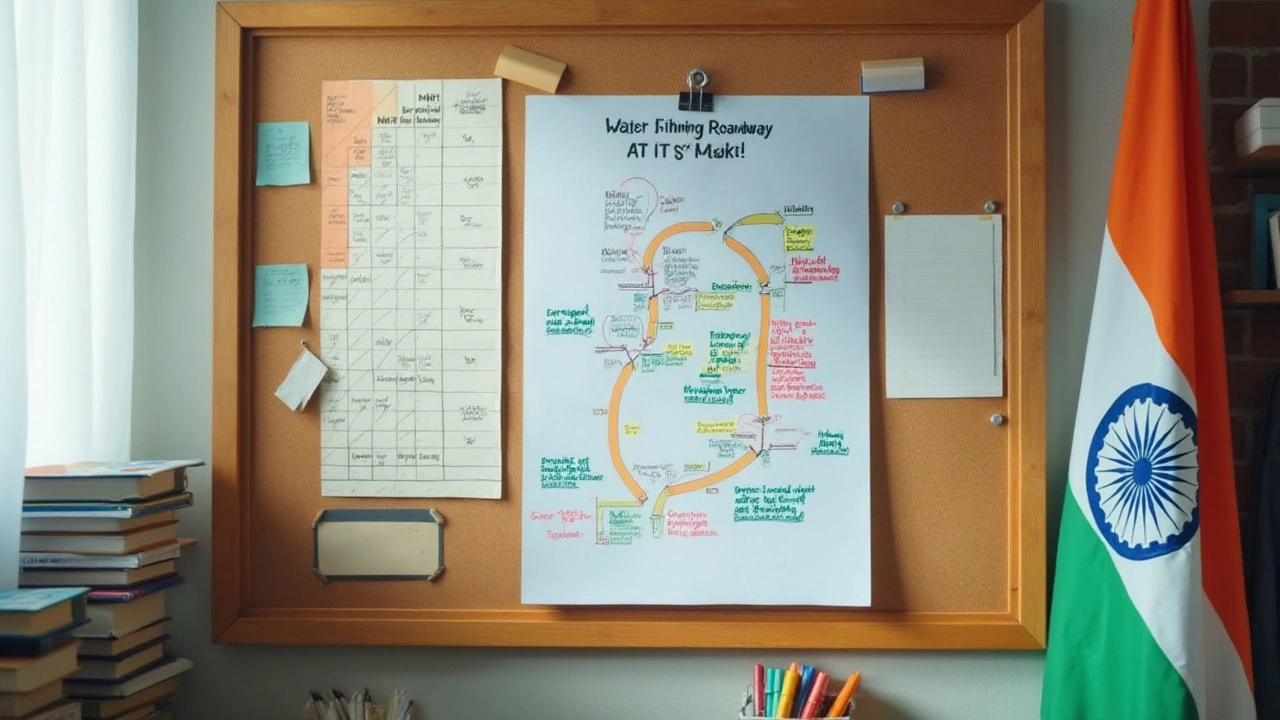Taking a chance at IIT Bombay with a 5000 rank might seem like a long shot, but it isn't the end of the road either. The dream to walk through its iconic gates is shared by thousands, each with aspirations as fierce as yours. While the competition is intense and the cut-offs are as if set in stone, a clear understanding of trends and smart choices can turn the odds in your favor.
Knowing what to expect is the first step. For different branches, the cut-offs vary each year based on several factors. Understanding these patterns over the past few years can provide a clearer picture of where your rank might stand a chance. While marquee courses often have stringent requirements, some equally exciting branches might still be on the table.
- Understanding IIT Bombay's Competitive Landscape
- Analyzing Cut-off Trends
- Top Branches for a 5000 Rank
- Strategic Preparation Tips
- The Path Forward: Making Informed Choices
Understanding IIT Bombay's Competitive Landscape
Delving into the competitive landscape of IIT Bombay is akin to embarking on a journey through one of India’s most revered terrains of academic pursuit. The Indian Institute of Technology Bombay doesn’t just represent a physical location; it stands as a beacon for innovation, excellence, and an uncompromising standard of education. Situated in the heart of Mumbai, it attracts some of the brightest minds across the globe, all vying for a place amongst its prestigious gables. The competition is fierce as IIT Bombay consistently ranks amongst the top institutions, not only in India but worldwide, offering courses that are globally acknowledged for their excellence.
Every year, over a million aspirants participate in the IIT JEE, and less than 1% find a place within the campuses of IITs, a testament to its rigorous selection process. IIT Bombay, known for its cutting-edge research and placement opportunities, often becomes the top choice for those with high aspirations. Consequently, the pressure to perform and secure a rank that can get one aboard this coveted institute is immense. Its hallmark programs such as Computer Science and Electrical Engineering carry cut-offs that only the top percentile can dream of achieving. The landscape here is sculpted by an unwavering commitment to quality and equality, where every rank counts and every mark matters.
Existing trends and academic forecasts play a significant role in shaping the competitive environment. Analyzing past admission trends show that branches such as Aerospace and Metallurgical engineering open themselves up to ranks around the 5000 mark, whereas disciplines like Computer Science remain elusive to all but the top 200. The cut-offs are not static but breathe with the changes in educational policies, quota introductions, and the number of seats available. Aspiring candidates should be well-versed in these dynamics, as they represent the living grid of chances and choices one faces.
"Success isn't always about greatness. It's about consistency. Consistent hard work leads to success. Greatness will come." - Dwayne Johnson
The data becomes crucial here; a glimpse into the specifics of rank distributions over recent years can unveil certain patterns. Consider a table where you might see how different branches accommodated specific ranks:
| Branch | Close Rank (General Category 2023) |
|---|---|
| Computer Science & Engineering | 203 |
| Aerospace Engineering | 4324 |
| Metallurgical Engineering | 5778 |
This table offers insights into how tactical choices, armed with knowledge of shifting statistics, can enhance your bid to enter IIT Bombay. Those willing to explore disciplines other than just the conventional 'top choices' often find themselves in fields that pave the way for groundbreaking research or innovative industry roles.
Analyzing Cut-off Trends
When it comes to securing a coveted seat at IIT Bombay, one of the key elements of preparation is understanding how cut-off trends shift over the years. It might seem daunting at first, but dissecting these trends offers invaluable insights into potential admission outcomes. Historically, the cut-offs for each branch at IIT Bombay have usually centered around various academic and application factors, creating a challenging puzzle for aspirants aiming for specific branches.
In the past decade, B.Tech courses like Computer Science and Engineering have maintained a tight squeeze, with cut-offs frequently landing below a 500-rank margin. Conversely, certain other disciplines, while prestigious, record cut-offs extending to the rank of around 4000 to 6000. For instance, branches like Metallurgical Engineering and Materials Science often see a relatively more accessible rank cutoff for IIT JEE aspirants. Students who are keen to enter IIT Bombay but hold a rank around 5000 might consider these branches as viable options.
Fluctuations Over the Years
The changes in cut-offs are not random; they mirror the collective interest in particular fields, job market trends, and department performances within IIT Bombay. A surge in an industry's job market, for example, can make its associated branch suddenly more desirable, tightening its admission cut-offs. Observing past data, it’s evident that an increased popularity in technology-related courses corresponds with lowered cut-off ranks—no surprise there.
Chetan Bhagat, in one such insightful commentary, once expressed, "Understanding the trends isn't just about numbers. It's about gauging where your passion aligns with potential opportunities." His words serve as a reminder for aspirants: knowing trends means matching your ambition with practical possibilities.
A deeper dive into cut-off statistics reveals that over recent years, due to adjustments in the number of seats available and curriculum changes, the rank requirements have occasionally relaxed in specific streams.
Understanding the Numbers
Delving into the exact numbers gives us precise clues about cut-off dynamics. The table below showcases a hypothetical sample of branch-specific cut-off ranks over the past three admission cycles. This illustrative data hints at possible outcomes:
| Branch | Cut-off Rank 2023 | Cut-off Rank 2022 | Cut-off Rank 2021 |
|---|---|---|---|
| Electrical Engineering | 1800 | 1600 | 1500 |
| Civil Engineering | 4500 | 4700 | 5000 |
| Chemical Engineering | 3200 | 3100 | 3300 |
Such figures help prospective students by providing a real-world gauge of a branch's popularity and competition level. With this understanding, students can strategically plan their options, positioning themselves where they still have a strong chance, even with a rank of around 5000.

Top Branches for a 5000 Rank
Securing a 5000 rank in the IIT JEE exam can open a variety of doors at IIT Bombay, allowing students to explore several interesting branches. While the most sought-after courses like Computer Science and Electrical Engineering typically require higher ranks, there are still top-notch options worth considering. Understanding subtle dynamics of the admission trends is essential; branches such as Civil Engineering, Metallurgical Engineering, and Aerospace Engineering might often accommodate ranks slightly beyond the usual prime cut-offs.
Let's dive deeper into these options. Take, for instance, the unique appeal of Metallurgical Engineering. As an esteemed field at IIT Bombay, it delves into materials science, offering robust opportunities in both research and industry sectors. For those inclined towards infrastructure and development, Civil Engineering often presents a solid choice, consistently valued in the job market. It's a field that combines technology with creativity and social utility, very much suitable for those who envision themselves contributing to the creation of society's tangible assets.
A special mention should be made of Aerospace Engineering. While it might seem niche, IIT Bombay's program is lauded for its comprehensive curriculum that covers avionics, aerodynamics, and space dynamics, teaching students to fly quite literally into a future brimming with possibilities. It's a commendable choice for those who harbor dreams of touching the sky, and often underrated in its accessibility relative to rank constraints.
"IIT Bombay's Aerospace department is not just about theory, but it's an invitation to explore the skies," remarks Prof. K. N. Muniappa, a renowned academic in this field.
Finally, a wise suggestion would be to consider the program structure and elective options that might align with one's broader academic or career goals. Realize the importance of pursuing passions, as it often leads to greater achievement and satisfaction, sometimes more so than merely following popular trends. When selecting branches, practical exposure, faculty involvement, and ongoing research can be factors as influential as traditional reputation.
Formulating a list of department-specific interests adjoining industry demand charts can yield insightful direction. Here's an example:
| Branch | Industry Demand |
|---|---|
| Civil Engineering | High |
| Metallurgical Engineering | Moderate |
| Aerospace Engineering | Moderate |
In the labyrinth of choices, let these options guide you through towards a path that not only fits your IIT Bombay aspirations but also personal interests. Remember, the rank is just a number; the real value lies in making each opportunity count.
Strategic Preparation Tips
Embarking on the journey of securing a seat at IIT Bombay with a 5000 rank requires more than just knowledge of subjects. It demands a strategic approach, harnessing each opportunity to maximize your potential. The first step involves understanding the core demands of the IIT JEE examination pattern, identifying subjects where you hold strong, and diligently working on weaker areas. Consistent practice is key, but tailoring your practice to simulate exam conditions can make a world of difference. Many experts suggest adopting a clear timetable that balances both study and leisure, allowing your brain to digest vast amounts of information without becoming overwhelmed.
Your strategy should also include analyzing previous years' papers to discern patterns and question types that frequently appear. Such recognition of patterns can sharpen your focus on important topics, ensuring that your study sessions cover essential areas comprehensively. Creating summary sheets or concise notes of frequently tested concepts can serve as quick-revision aids, easily revisited in the days leading up to the exam. Moreover, joining study groups or finding peers with similar goals can lead to constructive learning sessions where knowledge is exchanged, new perspectives are gained, and motivation levels are kept high.
Utilizing Resources Wisely
A wealth of resources is available online and offline, but smart utilization remains crucial. Enroll in a reliable test series that offers detailed performance analyses, helping you to pinpoint your strengths and weaknesses effectively. Dive into reputable books, recommended by IIT JEE veterans, and use them alongside your curriculum to deepen your understanding of complex topics. While books give the theoretical edge, videos and lectures from established educators provide practical insights and real-world applications of complicated concepts. It's about choosing resources that resonate with your learning style, ensuring your preparation remains smooth and efficient.
A wise approach also entails managing time efficiently during the exam itself. Allocate specific time blocks for each section, steering clear of time traps set by particularly difficult questions. Consistently practice with timed quizzes to fine-tune this skill. According to Professor R. N. Singh, an experienced head of coaching at a top institute, "Understanding the value of each question and when to skip those that bog you down can bag you precious marks that make all the difference.".
Maintaining Mental and Physical Well-being
Amidst challenging academic preparation, maintaining both physical and mental health is non-negotiable. Regular exercise, even brief, should feature in your daily routine, known to sharpens the mind and enhances stamina. Incorporating meditation or mindfulness practices counteracts stress, keeping your mind clear and receptive to new information. Balanced nutrition plays a crucial role, offering the energy required for intense study sessions. Sleep, often sacrificed in pursuit of more study hours, proves fundamental too. As research indicates, appropriate rest consolidates memories and encourages better problem-solving abilities.
Your strategic preparation journey shouldn’t be limited to books alone. Experience tells us that remaining curious, exploring beyond syllabus confines, craft the intellectual curiosity that institutes like IIT Bombay admire. Challenge yourself with science olympiads, participate in quizzes, and remain actively engaged with the world around you—it provides context and additional layers to theoretical knowledge. With a disciplined routine, focused strategies, and a nurturing mindset, you pave a promising path towards not just cracking the ranks but maintaining sustained academic success ahead.

The Path Forward: Making Informed Choices
When it comes to tackling the behemoth that is the IIT JEE entrance, specifically securing a spot at IIT Bombay, making informed choices is more a necessity than an option. The admission process is doggedly competitive, and being equipped with the right information can help you not only spot opportunities but make the most of them. A distinct possibility with a 5000 rank might not be the most obvious path or branch, yet it could still open doors to education at one of the prestigious IITs.
Grasping the nature of cut-offs is vital in making these choices. Historically, cut-off ranks are not static; they are influenced by factors including the total number of candidates, their performance in the exam, and the popularity of specific branches. Some branches at IIT Bombay, such as Metallurgy or Textile Technology, have been known to have cut-offs adjustable to ranks around 5000. It suggests that while you may not land the most sought-after Computer Science spot, there are still quality options waiting to be explored. Review previous years’ admission data to understand trends and set realistic expectations.
The decision-making process is also about playing to your strengths. Prioritize branches that not only align with your rank but also match your interests and strengths. Over time, a specialized branch in a seemingly lesser-known discipline can be more rewarding than mainstream ones. Consider looking into interdisciplinary courses or new programs, which might have slightly relaxed entry barriers but can offer robust career prospects. Once keen on a specific branch or specialization, gather information through workshops, seminars, or connecting with alumni.
The Support System: Resources and Mentorship
Besides technical expertise and personal interest, the resources at your disposal can significantly shape your journey. Utilize counseling sessions provided by coaching institutions that provide insights on trends at IIT Bombay and guidance on viable choices with your rank. There are platforms where you can connect with mentors or current students who have traversed similar paths, providing invaluable, firsthand information. According to a report by the Indian Institute of Technology Council, approximately 75% of JEE aspirants found mentorship pivotal during their preparation and admission process.
"The choices you make now can pave the way for your future in ways you cannot yet imagine," remarked Dr. Anil Jain, an IIT alumnus, who emphasizes the importance of strategic decisions in the early stages of one's postgraduate journey.
Ultimately, the key is to remain flexible. The initial expectation of studying a specific course might shift as new information and options come to light. It's crucial to keep an open mind and embrace alternatives. Institutes like IIT Bombay offer a versatile educational ecosystem where branches overlap, allowing collaboration across disciplines. Embrace the journey not just as a means to an end, but as an evolving path filled with opportunities that extend beyond the JEE results.
